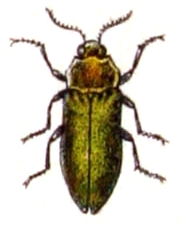Biology:Agrilus hyperici
| Agrilus hyperici | |
|---|---|

| |
| Scientific classification | |
| Domain: | Eukaryota |
| Kingdom: | Animalia |
| Phylum: | Arthropoda |
| Class: | Insecta |
| Order: | Coleoptera |
| Family: | Buprestidae |
| Genus: | Agrilus |
| Species: | A. hyperici
|
| Binomial name | |
| Agrilus hyperici Creutzer
| |
Agrilus hyperici, the St. John's wort root borer, is a species of jewel beetle. It is used as an agent of biological pest control against common St. John's wort (Hypericum perforatum) in areas where it is a noxious weed or invasive species.[1][2]
Description
The adult beetle is narrow and elongated, reddish-brown in color and about 5 millimeters in length.[1]
Biology
The female deposits eggs low on the stem of the St. John's wort plant in July and August.[1] The larva emerges from the egg and makes its way to the roots where it feeds on root tissue for the following year.[1] Often the larvae consume nearly all the roots on a plant and then pupate inside the remnants. Few plants survive attack by this species. The beetle is known to attack the similar plant goldwire (Hypericum concinnum) in California , but it does not appear to have a destructive impact on this species.[1]
Distribution and habitat
This beetle is native to Europe.[1] Its association with Hypericum perforatum has been known for a long time and it was first introduced to the United States for the purposes of biocontrol in 1950, in California.[1] It is now established in much of the northwestern United States, especially in mountainous areas, and in Australia.[1]
References
Wikidata ☰ Q4469837 entry
 |

